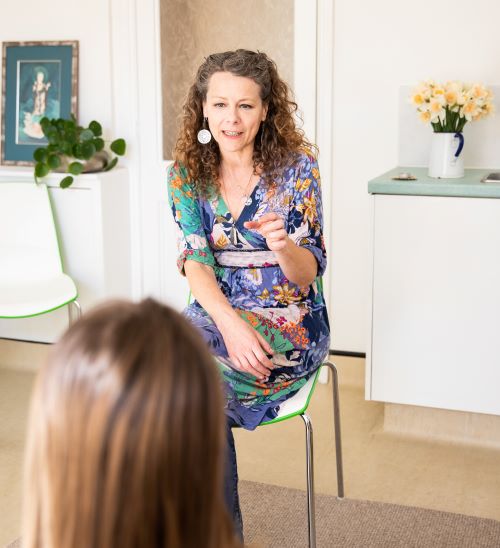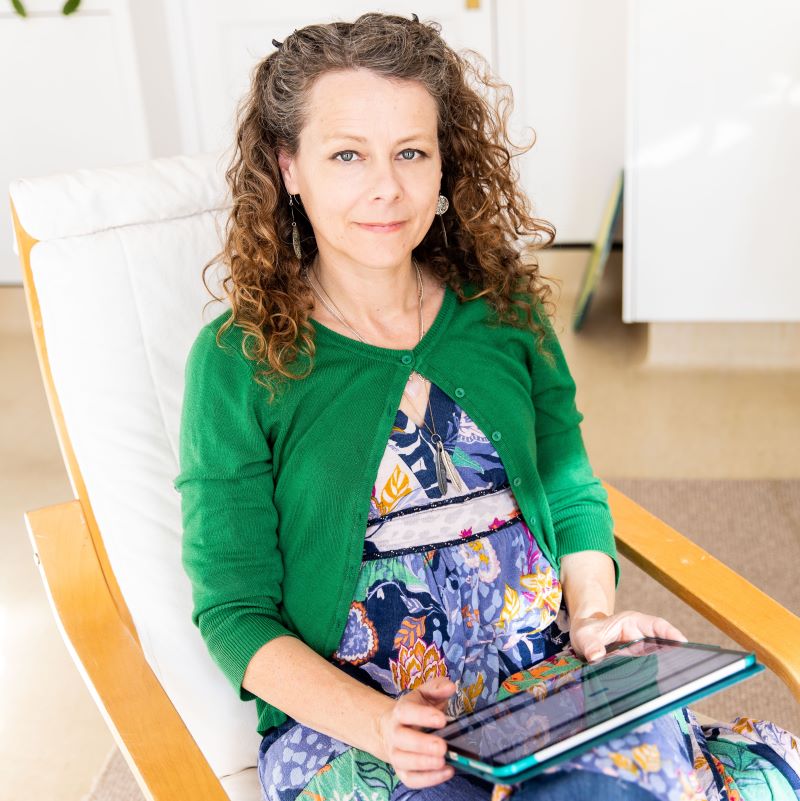Advertising feature by Sally Churchward.
Birth trauma and Bodywork therapist, Kirsteen Anderssen, uses a range of techniques to work with clients suffering PTSD following childbirth trauma, anxiety, depression or people who just want to better understand their own nervous system and triggers. She explains her approach and how transformative it can be.
It’s easy to think that Post Traumatic Stress Disorder (PTSD) only occurs in extreme and unusual situations – soldiers on a battlefield, survivors of violent crime, and so on.
But a far wider range of events can cause trauma, and in around a fifth of people, rather than that trauma being processed to become a memory – albeit an unpleasant one – the experience continues to feel present, as if it’s happening right now in their everyday lives, sometimes decades after the original trigger situation.
Kirsteen Anderssen, a Southampton-based former midwife, specialises in therapy for birth trauma, which occurs when those involved in childbirth, pregnancy and newborns, suffer a traumatic experience that remains with them as PTSD. This is often mothers, but she also works with partners, midwives and other medical professionals.
“We used to think that trauma was an event that happened, but now we realise that trauma is actually the impact of that event on our bodies and nervous system,” she explains. “When people go through a traumatic experience, about four fifths of them will process that trauma in the following month to six weeks.
“This means they will likely experience post trauma symptoms like flashbacks, re-experiencing, nightmares, high anxiety or hypervigilance, but at some point they are able to process that the thing isn’t happening anymore.
“Whilst they are experiencing those symptoms, the memory appears to be alive in the brain. Then once they’ve processed it, the memory is a bad memory, but it’s in the past, it’s not experienced as live anymore. The person can look back and say ‘what a terrible experience’ but it doesn’t set off anxiety symptoms or avoidant symptoms.
“Around a fifth of people are unable to do that. So what happens is that, over time, we tend to find strategies to continue to live – but we will try as much as possible to avoid being triggered, because we will then continue to experience it in our bodies as if it’s really happening now.
“We think, particularly with birth trauma, that the fraction of people who can’t process it properly is even higher. About a third of women cannot process the trauma that they’ve gone through, and that’s mostly because they’re now looking after a baby and are exhausted and under-resourced etc.”

Kirsteen is keen to emphasise that birth trauma can, and often does, occur in births that would be considered ‘straightforward’ by medical professionals. Indeed, in the case of tocophobia, the severe fear of pregnancy and/or childbirth, anticipation can create trauma – in this case it may be due to the brain, body and nervous system ‘pattern matching’ to something that has happened previously.
Kirsteen continues: “It’s very common for people to experience what a midwife might call a ‘normal birth’ or an ‘easy birth’, but for that person giving birth to experience something very different. Birth trauma is not a very accurate term because actually I work with people who experience IVF and ongoing fertility issues, people who have had miscarriages and people who have had trauma during pregnancy. It’s also during the birth and the postnatal period. It can be a baby that can’t breastfeed, a baby that screams all the time, a baby that ends up having to be in the neonatal unit.
“It spans a whole timeframe, and it’s not always what we might perceive to be a disaster. In fact something that almost always comes up is relational trauma.
“Trauma can be described as too much for too long without adequate resources or resourcing, so we’re very overwhelmed, but it can also be not enough for too long, so the absence of care or the absence of relational experience for too long.
“A lot of women say they were not treated with dignity, they were not cared for, they weren’t treated like a human being. Often it’s that absence of care, someone not seeing their distress, someone not believing them, not taking the time to cover them over.
“Sometimes those wounds run just as deep.”
Kirsteen adds that the birth partner may experience trauma even when the mother does not.
“If the woman is whisked off for an emergency C-section and the partner is left in a room pacing with no information about what is going on, that can absolutely cause trauma,” she says.
“I’ve worked with a lot of partners who just had absolutely no information and who have had post-trauma symptoms where the woman has gone through something that was difficult but has been aware of what was going on and wasn’t traumatised.
 “With professionals, it’s often a combination of experiences. We know that trauma can have a slow burn effect, so if you have cumulative trauma, you can keep tolerating it and keep tolerating it and there might be one thing that on the face of it, doesn’t look that big, but it’s the straw that broke the camel’s back and that’s when people talk about burn out. The capacity to withstand and tolerate stress becomes so narrow that there is none left and then people can’t make good decisions.
“With professionals, it’s often a combination of experiences. We know that trauma can have a slow burn effect, so if you have cumulative trauma, you can keep tolerating it and keep tolerating it and there might be one thing that on the face of it, doesn’t look that big, but it’s the straw that broke the camel’s back and that’s when people talk about burn out. The capacity to withstand and tolerate stress becomes so narrow that there is none left and then people can’t make good decisions.
“Often I have worked with people who have had their own personal experiences of trauma and birth trauma, which then became triggered at work and then they became seriously unwell.”
Birth Trauma is not counselling, and Kirsteen says that while often people do want to tell their stories, it’s not necessary for the therapy to be effective.
“I do listen to people’s stories and there is a lot of validation and holding, because for a lot of people it’s the only place they’ve got where they can come and tell their story without other people being triggered,” she says. “I also tell people about what the nervous system is, how it works and what it feels like when we are no longer within our window of capacity. That starts to explain things like sympathetic nervous system responses like flight, so if flight isn’t available to you, you can’t run away you might get angry and if that’s not available to you, you might fawn, you might people please and consent to things you don’t want, and it’s all about it becoming too much and you will just freeze. What happens in those freezes is you often can’t speak, you often feel disconnected from the reality of what’s going on. That’s what can happen.
“When I explain to people about the nervous system and how we experience those things, it often takes a lot of the shame away.
“Often people will say ‘why didn’t I say something’ or ‘why did I do that’. So there’s lots of explaining about what happens when you become triggered, what happens when your nervous system becomes overwhelmed and re-experiences trauma. You’re not crazy and this is what is going on. This is why your nervous system is behaving like this.
“Each nervous system phase has thoughts that go with it, and you’ll start to think in a particular way. When you are in sympathetic nervous system, your survival system is looking for danger, so you’re more likely to see danger, you’re more likely to become anxious.
“We do a lot of learning about the nervous system and also somatic practice to start to allow them to calm and come back to a place of safety and we’ll brainstorm ways of broadening their bandwidth over time, so they can start to build capacity.”
Kirsteen emphasises that it’s important to work with people in this gentle way, to avoid them becoming retraumatised.
“If you try to process trauma without building that capacity, people become overwhelmed and that’s how people become retraumatised so we just don’t ever do that, we spend a lot of time understanding what’s going on and learning how to access the sense of calm, and that’s very individual.”
Kirsteen recognises that while some clients come to her feeling very motivated, that’s not the same for everyone, and she tailors her approach to her clients.
“Some people have no capacity to do anything between sessions for the first few times and that’s fine. We have them do stuff while they’re with me, but over time, I might make a recording for them, that they can take away and listen to, or I will offer things as simple as if you take 5 breaths with your outbreath longer than your inbreath, it calms you down. That takes less than a minute so we’ll build up to them practising that for a few minutes between sessions. I’ll start wherever that person is at.”
Kirsteen frequently sees people within five years of childbirth but some clients make contact after much longer, with many coming ten or more years later, and one coming 37 years after a particularly traumatic experience. She emphasises that there is no time limit to the benefits of seeking help.
She adds that while there are a number of PTSD symptoms, people do not need to have all of them to warrant a PTSD diagnosis, and she has seen clients who only display one symptom, but that symptom has been getting in the way of their lives.
She says that it’s important to highlight that people do not generally experience flashbacks – which are commonly associated with PTSD – as a mental replaying of an event, like a film in their mind, but as somatic or emotional flashbacks – so something may trigger a sense of panic or nausea without the individual realising what the trigger was, or even that what they’re experiencing is a flashback.
Kirsteen adds: “The most common thing that people say is ‘is it a bad enough experience to be a trauma?’, I say ‘if it’s impacting on your quality of life, then yes, it is.’”
The other side to Kirsteen’s practice is Body Work.
She sees people with generalised anxiety, panic attacks, and disassociation, as well as a growing number of neurodivergent clients, who have heightened sensitivity and want to better understand their own nervous systems.
“With Bodywork clients, people often come to me with a pattern of being,” she says.
“I call it a ‘home from home’ that we go to in our nervous system, which will be fight/flight/fawn/freeze or it will be the absolute drop down into depression and dissociation.
“Some of those people I might work with for years, but some I work with for six or eight sessions and help them understand their nervous system and how they can build that window of capacity which allows them to feel safe and connected for longer, looking at why they might get activated into sympathetic nervous system and then how to come back down again.
“They will have traumas so I work with them mostly using somatic practice and also using the rewind technique, which is very effective for phobias and trauma.”
Kirsteen explains that the techniques she uses get good results over a fairly short period of time.
“If people present with PTSD, nobody leaves (at the end of the course of therapy) with those symptoms. That’s never happened,” she says.
“It tends to be within five sessions. If another trauma comes up we might then have to do another few sessions so that type of intervention is very quick.
“The people who come to me long term tend to be people who I offer my reduced rate slots to.”
 Kirsteen’s approach is very different to talking therapies.
Kirsteen’s approach is very different to talking therapies.
“It’s working with knowledge and understanding of the nervous system, which is key to trauma and anxiety. I had a client recently who had done seven years of CBT who found it really helpful to talk about it, but it didn’t take their symptoms away, so they were still experiencing post-trauma symptoms that were debilitating. What I do is work physiologically, with the nervous system, to take away those symptoms rather than talking about what happened. While a lot of people do want to talk about their trauma you don’t have to talk about it in order to be able to do the treatment. You don’t even have to disclose what your trauma was.
“What I want to know is how it is impacting your body now, what are you experiencing now, let’s work with that. I think people think they’re going to come in and have to dissect every detail of their pain and actually that’s the last thing I want people to do. I want people to operate within their window of capacity and not be pushed over the edge, so sometimes people will see me and not even talk about what happened to them for three sessions. Even then they might drop in a little bit and that’s fine.
“You have people just touch upon and activate their nervous system a little bit by remembering a little bit and then supporting them to come back into a place of calm and safety, so they’re not really going over that threshold and becoming massively activated. I have really good results with people working in that way, and again, they don’t have to go into all the details if they don’t want to.”
Kirsteen adds that some people may know they need help but not have a sense of what is causing their anxiety or other issues.
“I’ve got clients who have said ‘I don’t really know why I’m here. I get really anxious all the time and I don’t know why.’
“When you’re activated and experiencing trauma symptoms, you don’t really have good access to your prefrontal cortex, which is your thinking, logical, rational brain. What people will do is once they’ve done more of the nervous system somatic work and they’re able to access that place of calm, their front brain comes online again, and they’re able to make sense of what’s happened and then they can start to understand it and articulate it.”
Kirsteen says that she has been seeing a growing number of neurodivergent clients, which has developed through word of mouth.
“A lot of people who are neurodivergent have a more sensitive nervous system around sensory stuff, so a sound that might not send me over the threshold into the sympathetic nervous system might send an autistic person into sympathetic nervous system. That would be the same with touch. So the sensory system is more sensitive within people with trauma but also with neurodiversity.
“I can support people to understand this and then strategise with them about putting things into place. For some people, there can be a lot of shame.
“I have younger people who are autistic and they’re more owning of their autistic nature and understand about it, but with adults who didn’t know they were autistic – who have now found out – often they’ve had to try to mask and fit in.
“Our work is about who you are, what you might need, and why. So it’s supporting people to put out what their needs are and get those types of things into place, for them to understand themselves and for other people around them to understand, as well as understanding about masking and fawning.
“With a lot of people who weren’t known to be autistic, they were told they were too much: ‘there’s nothing wrong, there’s not a loud noise, I’m not touching you hard, what’s wrong with you, sit there and stop moving’. We do so much invalidating so people end up having loads of internalised shame and those people end up fawning and appeasing a lot of the time, they’ve cut off from their own needs and want just to help calm everyone else down.
“So we do lots of learning and understanding.”
As well as offering therapy, Kirsteen spends time on the other side of the relationship, and believes this is very important when supporting others.
“I have three supervisors for the different things that I use, and I also do my own somatic practice and my own body-based therapy from a separate therapist. That feels key to my values as a practitioner, that I work with my own nervous system, I work with my own story, my own trauma and I have regular supervision for the work that I do.”
As well as her one-to-one practice, Kirsteen runs a monthly trauma-informed body based psychotherapy group, in St Denys, with a psychotherapist.
“It’s an Action Method way of looking at what’s going on for you,” she explains.
“It could be people with low self esteem, trauma or chronic illness. We particularly welcome people with chronic illness and we look at trauma and how that contributes to it.”
In whatever area she is working, Kirsteen is keen to emphasise that she is always working with the individual, to find out what’s going on for them and what their needs are, whether they are suffering from birth trauma, anxiety or are there to get a better understanding of their own bodies and minds.
“Everyone’s so different and that feels really key to my work with anybody,” she says.
“ I’m not interested in a blanket approach. Your nervous system is yours and not anybody else’s and I want to work with you.”
- For more information, email: contact@kirsteenanderssen.com, call 07772059044, or visit: www.birthtraumahampshire.co.uk/
In Common is a grass roots community publication. We run largely on donations from readers and also accept adverts from selected advertisers, such as this one. For more information about advertising with us, please email: editor@in-common.co.uk

